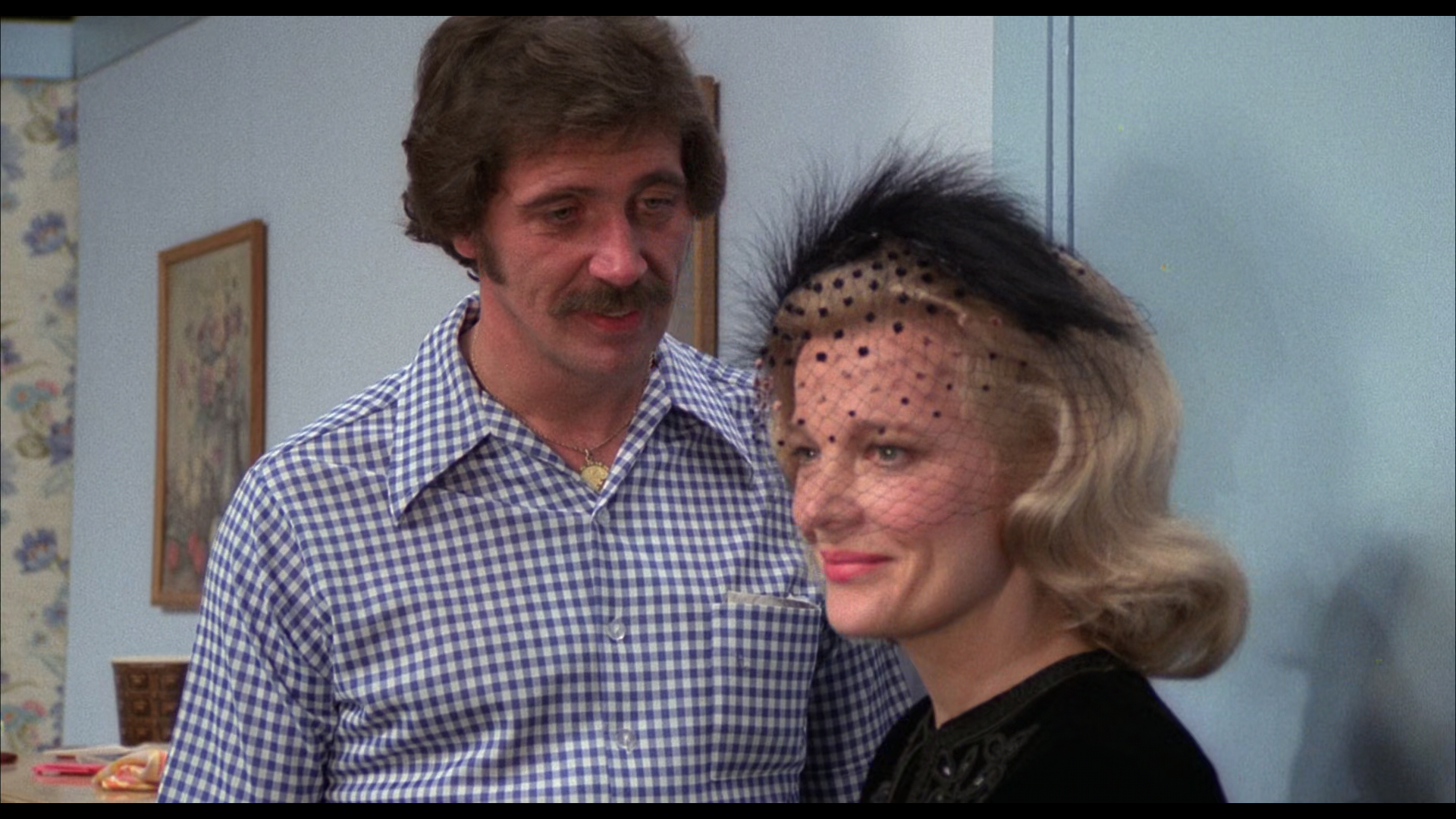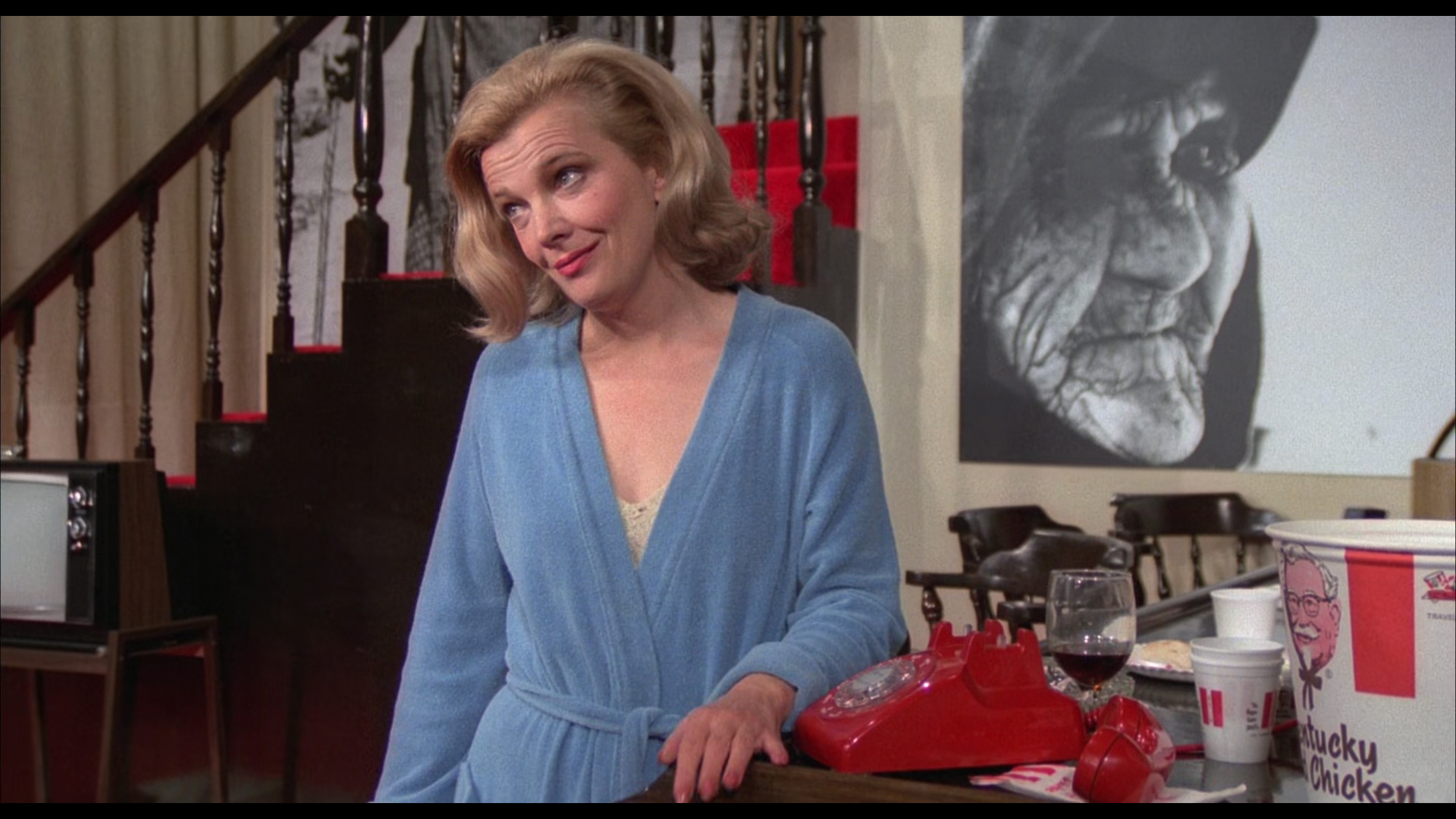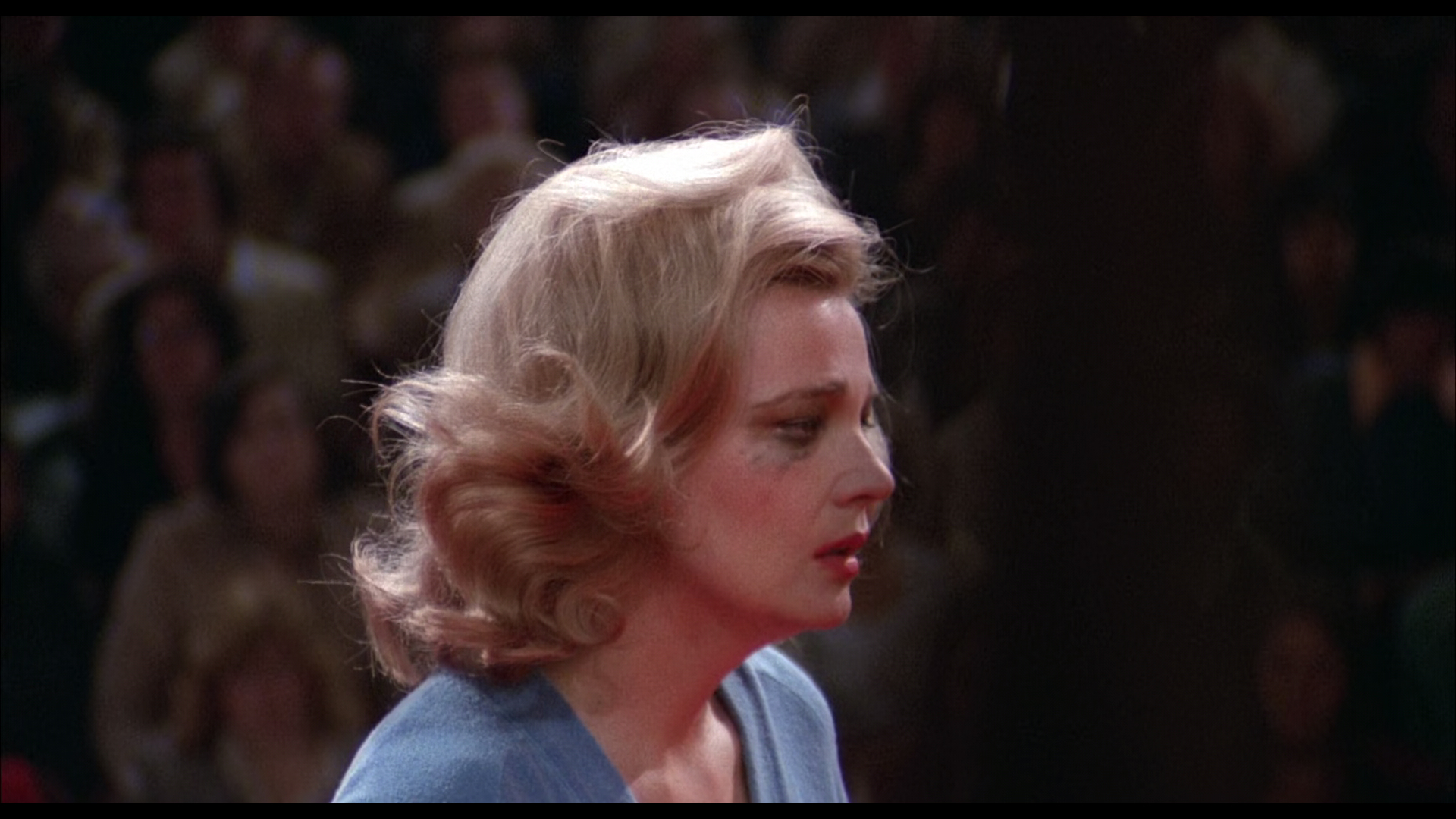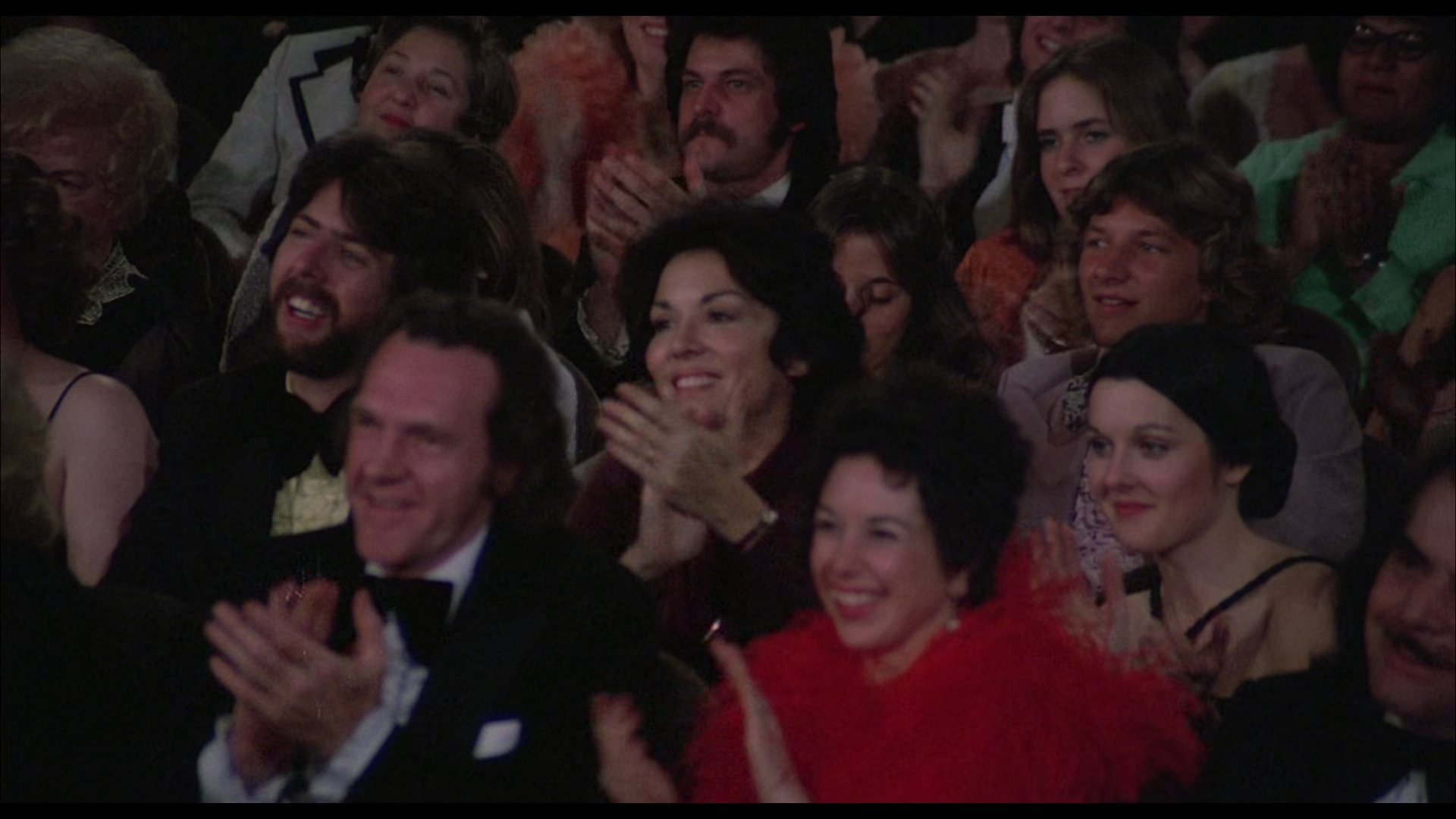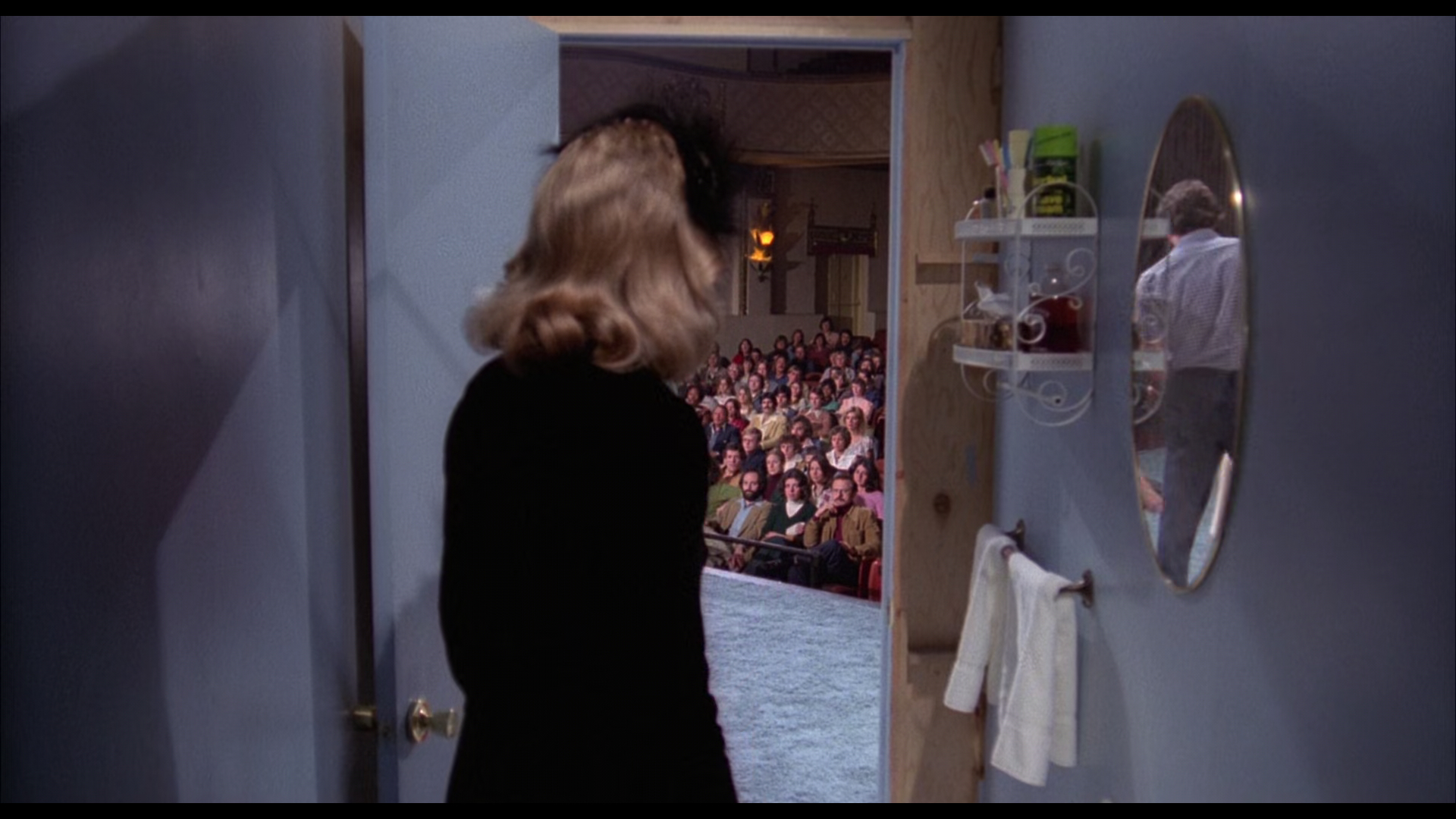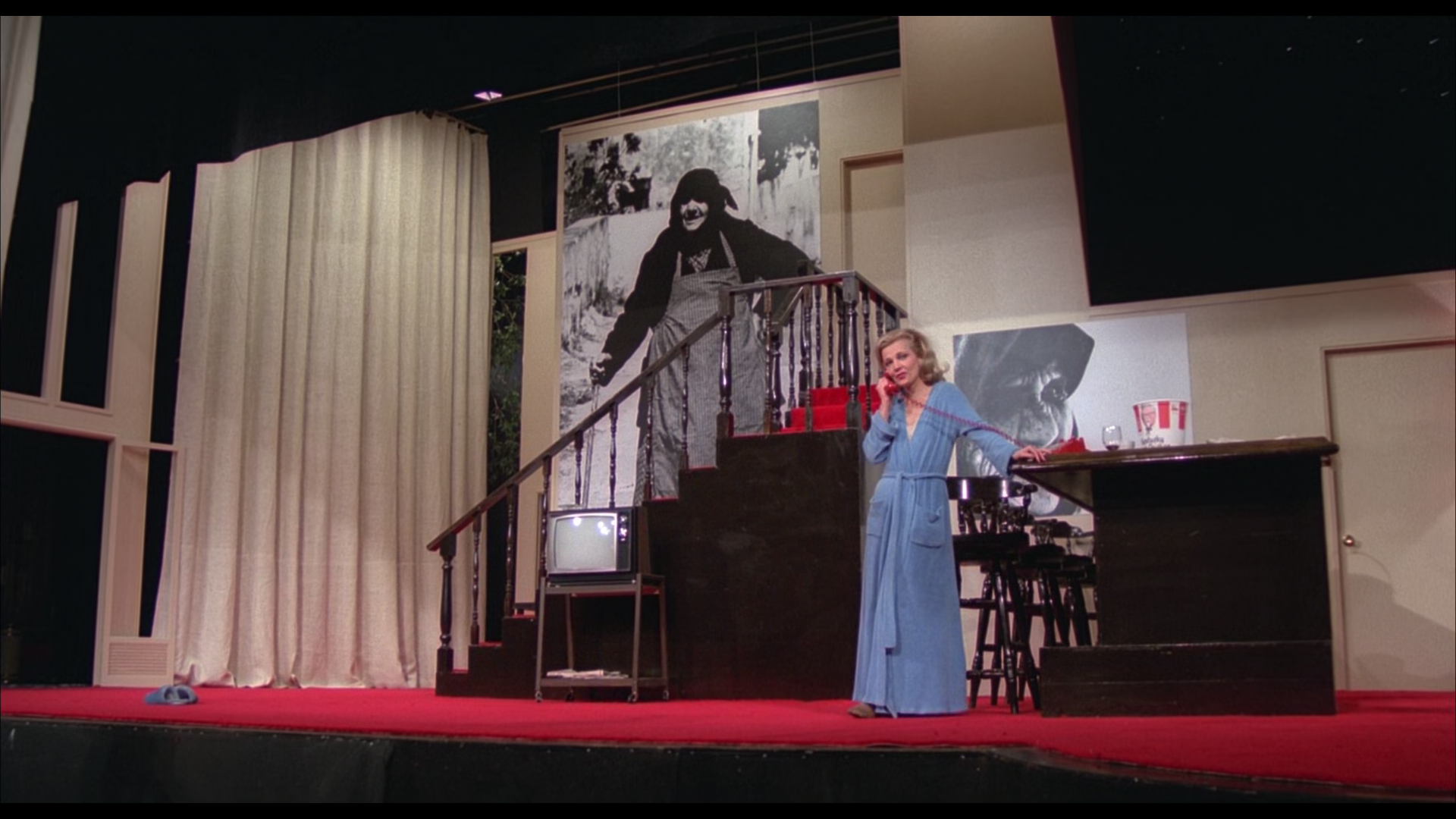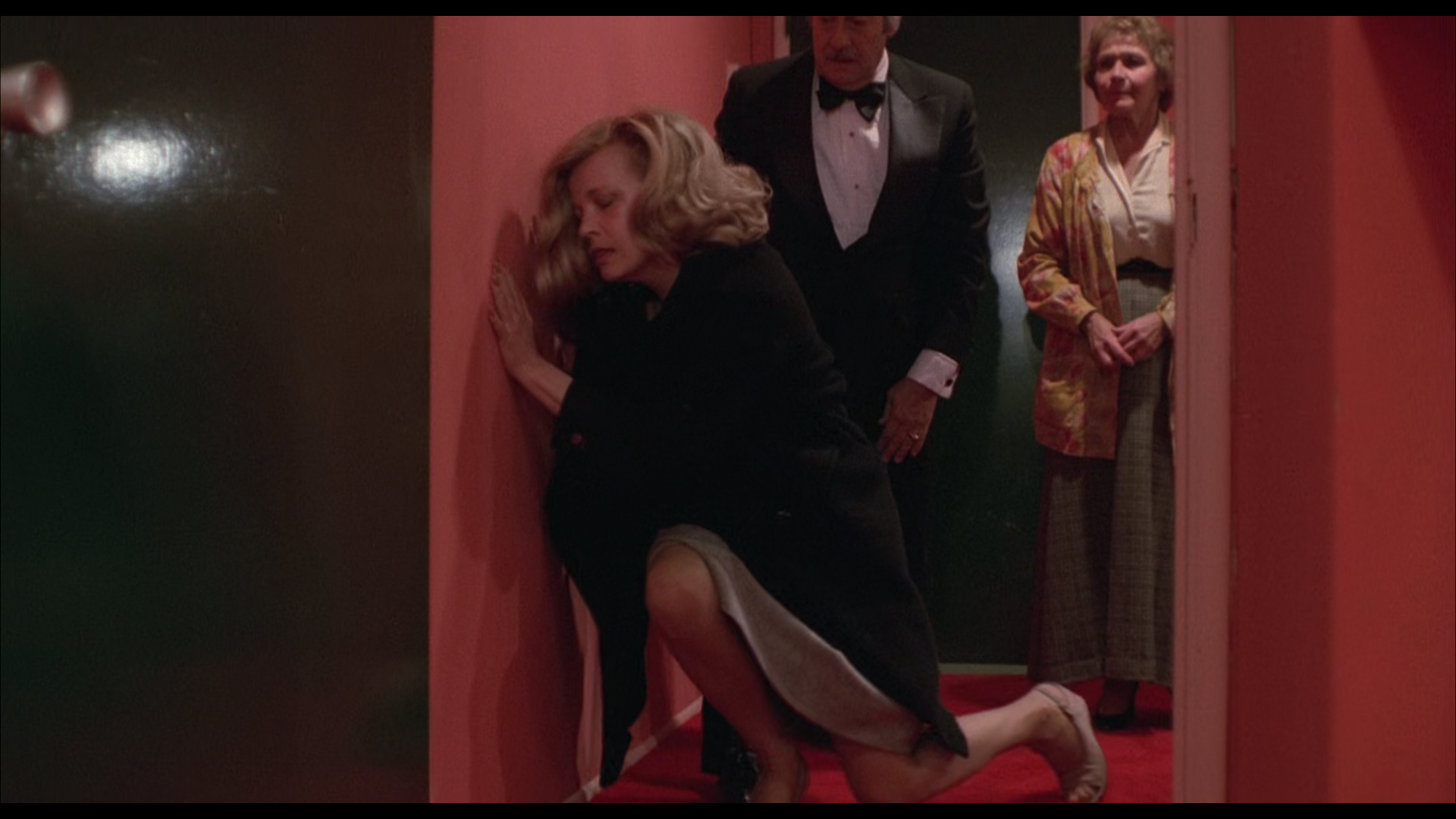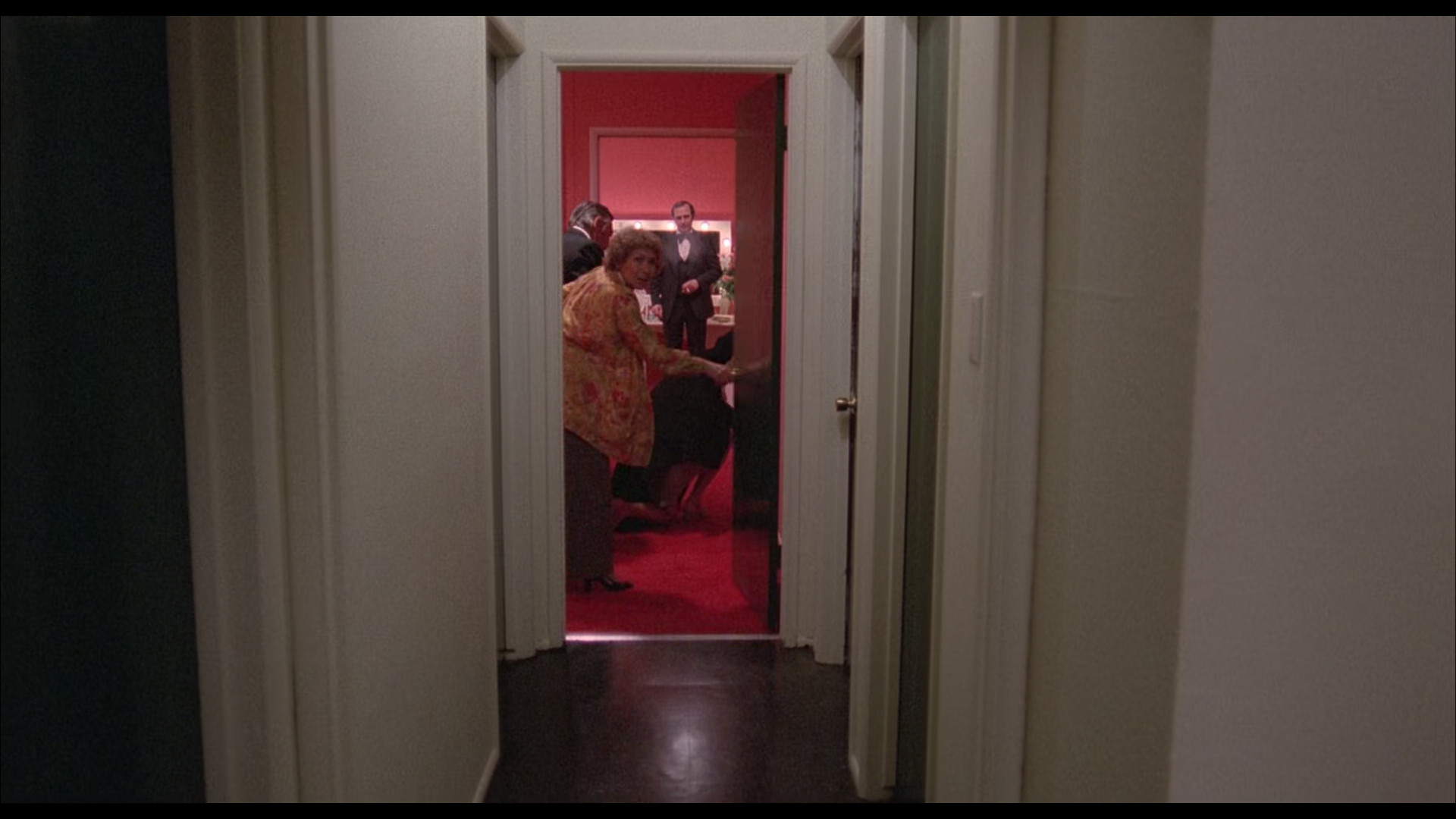“I think it’s wonderful how you told everyone Maurice is an actor.
I mean, no one would have known if you hadn’t told ‘em.
And I think it's marvelous… how accurately you described
to the audience… what they were watching: a play.” – Manny
Opening Night (1977) recounts the story of an actress (Gena Rowlands) who has trouble understanding and accepting her role in a theatrical production. The premise of the film is thus a framed narrative: a director (John Cassavetes) is directing an actor (Ben Gazzara) to direct actors (Rowlands and Cassavetes) that are playing actors (Myrtle and Maurice) playing the leading roles (Virginia and Marty) in a theater piece. The different levels of the story appear strictly separated at first - the backstage is as important as the play - but start to overlap at a later stage, creating a mise-en-abyme of people, actors and characters. Deconstructing the mix-up of reality and fiction on the different levels lends itself to exploring the questions of theatricality and absorption as they have been thoroughly researched by art historian and critic Michael Fried. Which acting is staged and paid for, and which acting is a part of life and everyday? How do the different audiences (in and out of the film) relate to the actors, the play, the plot? Before tackling these questions, I will first rephrase Fried’s central ideas and second, open up a broader understanding of Opening Night’s layered being.
Absorption and Theatricality
When art critic Michael Fried (1980) wrote about the relationship between a spectator and an artwork looked at, he was talking about 18th century painting, invoking French writer, philosopher and art critic Denis Diderot. Diderot regarded the perfect play and the perfect painting as depicting figures or characters absorbed in their own diegetic reality, which appears as a fiction to the onlooker. The fourth wall thereby erected enthralls the audience, because it allows them to indulge their voyeuristic tendencies. In Absorption and Theatricality: Painting & Beholder in the Age of Diderot (1980) Fried defines the state of absorption as “being wholly engaged in quintessentially absorptive activities.”1 Typical “vehicles of absorption”2 are “sleep-related stares and activities.”3 Other examples are memorizing a lesson, meditating and reading.4 In general the ‘absorptive tradition’ exists out of paintings that thematize “engrossment, reflection, reverie, obliviousness, and related states.”5 According to Diderot, the primary exponents of this tradition were Jean-Baptiste Greuze and Jean-Baptiste Siméon Chardin, whose paintings depict figures entirely absorbed in their own act, but there are examples to be found in the theater as well - “act as if the curtain never rose.”6 Absorption establishes the most natural and realistic depiction of life, in which the viewer does not take part and is not asked to be aware of his own position, allowing him to be immersed and to transpose the absorption seen to his own viewing practice – thus experiencing absorption. In this moment, when the picture seems not to be painted at all (the play never staged), the artist has established a sincerely anti-theatrical work. This refined absorptive sensation is countered by theatricality, a notion Fried once again borrows from Diderot for whom the concept was problematic:
On n’a point encore fait, et l’on ne fera jamais un morceau de peinture supportable, d’après une scène théâtrale; et c’est, ce me semble, une des plus cruelles satires de nos acteurs, de nos décorations, et peut-être de nos poètes.7
The effects of theatricality are visible in two stages. Primarily it governs the (status of the) work itself. According to Diderot, if some of the figures in the scene appear to be less than wholly absorbed by what they are doing or by what is happening around them, and instead are “conscious” of their being beheld, it renders both the figures and the painting theatrical, which the critic names “falseness.”8 In a second stage it affects the audience: a theatrical painting is unable to retain the attention of the viewer. By reaching out to its audience, the work of art makes the viewers aware of their own act of spectating, breaking the spell. Theatricality counters truth and conviction, rather installs a distance that bears no credence. A theatrical work is merely readable in its context, confronting its beholder, standing “in his way.”9 The importance of differentiating the first stage – which ultimately serves the second in its purpose of an altered perception – from that second stage, lies in the recognition that in painting this ‘consciousness of being beheld’ is still in the hands of the painter. In painting, both stages overlap or are seamlessly complemented through the artist’s solemn reign, acknowledging the inherent theatricality of creation. In cinema and theater, this first stage partially comes to lie in the hands of the actors, opening up a slightly more nuanced question. Possibly, a source of frustration for the director. If absorption within theater or film fails, Fried (in accordance with Diderot) writes, it might well be the doing of the “seemingly innate theatricality” of actors who seem unable to “subordinate them[selves] to the demands of the art.”10 Diderot had earlier noted that it are often the untrained, unknown extras on stage that prove resistant to theatricality and are better capable of displaying absorption.
Apart from historical painting, the notions of theatricality and absorption have been widely reapplied to analyze more modern painting, sculpture, theater, photography and cinema, not in the least by Michael Fried himself. The critic researched the idea of theatricality and absorption in historical painting, after a first attempt to separate modernist from Minimal art in his 1967 essay Art and Objecthood from a very similar point-of-view. In this essay he claimed Minimal art is literalist art that feeds off its context (the space and visitors of a gallery or a museum) and is therefore theatrical. He noted that anti-theatrical art exists and has meaning in itself and does not need an audience or a context to be understood or even perceived the way theatrical art does: “it is as though […] a work of modernist painting or sculpture – were in some essential respect not an object.”11 Fried broke down this question of physicality into present-ness and presence. Absorptive art has a certain presentness, which lies within the work and which is timeless and spaceless. It functions as “a closed and self-sufficient system,”12 independent from anything outside its frame, independent from its material. Theatrical work, on the contrary, feeds off its (ephemeral) presence in the room, presenting itself to the beholder, dominating “the entire situation”13 wherein the actors and the audience are both present.
Cinema on Stage, Cinema in a Gallery: Theatricality and Film
Cinema cannot be experienced with the same shared liveness as is possible in theater. Cinema’s (a)materiality forms an obstacle, it is experienced through a (distancing) machine. A film bears no presence since it is “screened”14 and not exhibited. Because of that, Fried writes, “the engrossment of the movie audience sidesteps the question of theatricality.”15 These claims leave cinema out of the debate. Film and philosophy scholar Matthew Abbot affirmed this blind alley, writing that “the result will be neither theatrical nor anti-theatrical, for cinema has no mode of address in the strict sense,”16 referring to the technical or material distance. Abbot’s answer is to leave behind this impasse, suggesting to analyze cinematic absorption “without presupposing it is a function of illusion.”17
Abbot (2017) analysed Abbas Kiarostami’s Shirin (2008) in terms of absorption and spectatorship. He is concerned with the social and public implications or justifications of theatricality, though the political or social criticism in Shirin (2008) is performed through absorptive means. By presenting a series of portraits of famous (mostly Iranian) actresses watching a film, without showing the film they are watching, Shirin demonstrates that self-reflexivity does not necessarily undermine absorption:
In his further research, Fried acknowledges the ambiguous position cinema is in, unable to absorb an audience into its materiality and at the same time allowing the audience to become fully absorbed in the film without having to be present. Yet here Fried argues that the absorptive character comes too easily to cinema: its mere negation of theatricality does not render cinema “a modernist art”19 that so successfully demonstrates absorption. In cinema, the audience is present in the “experiencing machine,”20 an idea Fried takes from Jeff Wall. Trying to fit Opening Night into the spectrum of absorptive to theatrical art, from here on, thus moves past the claim of materiality. Although Fried ensures us that it is not the question of materiality that makes him say cinema sidesteps theatricality, it is difficult to grasp what exactly does.Shirin reflects on the problematic status of cinematic absorption with cinematic means, and it is hard to imagine a more absorbing treatment of it.18
In Four Honest Outlaws (2011) Fried turns back to the obstacle that is called cinema, compelled to rephrase and rethink how cinema - automatically - sidesteps theatricality. Fried believes there is more to it than the argument of materiality and acknowledges once again the fact that absorption and anti-theatricality can be attempted with cinematic means. Classical narrative cinema, he argues, strives for absorption, just like any other visual art can do, but in his writing the critic puts great emphasis on the plot, the fate of the characters, the narrative, rather than the actor’s singular movements, gestures, postures. In Opening Night, both audiences (in the film or watching the film) are grabbed by the unparalleled performances of Rowlands. However much one wants to understand the vocal expressions coming from the haunted, ill, or distressed characters placed in the center of (all of) Cassavetes’s film(s), his characters speak with their bodies, as examined by Vincent Amiel (1994), Philippe Lubac (2005) and in some respect by Todd Berliner (1999) in his writing about the ‘real realism’ of Cassavetes. The absence of a well-defined narrative, such as in most of Cassavetes’s movies, had earlier allowed the viewer to enjoy the absorptive paintings by Chardin and Greuze. In these paintings, just as in Cassavetes’s work, it is mostly the curving of a body, the direction of a pair of eyes, the gesturing of a hand, a frown or a gaping mouth that is central to the image, that tells what one is “doing, hearing, thinking, feeling,”21 and that gives away the level of absorption of the figure(s) depicted. Nevertheless Fried writes that in narrative cinema we are “hooked by an event,”22 which sounds like an unfair suggestion, compared to our self-explanatory fascination for the gesturing of a painted student of Greuze.
Cinema recontextualized in a gallery or a museum also makes absorption (into the plot) impossible for the visitor, because of the way the films are often mutilated (cropped, extremely slowed-down, cut into concomitant pieces). The visitor can however focus his attention on the absorption the actors seem to inhabit, their movements dragged, dramatized, debilitated. In a gallery, there is room for fascination in gestures, although Fried applauds the absence of famous actors in the experimental film art of Douglas Gordon, because these actors’ idiosyncratic movements, mannerisms and tics - which we are familiar with - would take away our chance to become absorbed. Does recognition kill absorption? In this case, Opening Night is beyond redemption, since Cassavetes is known for always working with the same people who were his close friends and family. Rowlands’s movements are very much her own and ever-returning in every film she made with her husband. Fried distracts us from the discussion of absorption in cinema, by moving it once again to the realm of gallery art. Nevertheless, the “derealization of the exhibition space,”23 to the critic, is a feast of anti-theatricality. I suppose substituting ‘exhibition space’ with ‘cinema hall’ is not too far-fetched and we can make claims of anti-theatricality in ‘normative’ cinema. I will treat Opening Night seen from a fictional liveness (often hard to distinguish from lived-ness and likeness), that is present only within the film (as theater) or seen as a shared experience of the audience outside of the film - where sometimes it clashes with the considerations of the former.
In an earlier essay, Jeff Wall, Wittgenstein, and the Everyday (2007), Fried applauds the anti-theatricality of the contemporary photographic works of Jeff Wall, reminiscent of the 18th-century painterly tradition, yet immediately remarks that it cannot compete with Chardin and Greuze because one can see that the subject photographed was well aware of the presence of the photographer. Therefore Fried calls it a “staged” form of absorption.24 Reacting to this essay on Jeff Wall, critic James Heffernan (2008) questions the notion of staged absorption, using another example provided by Fried, namely Lesende (Hans Richter, 1994), a painting depicting a woman reading, which is painted after a photograph. Fried calls it staged, because the young girl must have noticed the photographer shooting her portrait. Heffernan replies by asking “how Chardin’s absorbed young men [could] have failed to notice the man with the paintbrush and easel?”25 For Heffernan the answer merely depends on the ontological fiction. Once we abandon our suspension of disbelief (accepting the inherent theatricality), a whole array of different kinds of absorptions offer themselves in the scope of being real versus being staged.
Following Heffernan, differentiating Chardin’s real absorption from Wall’s staged kind, is hardly sustainable. Heffernan challenges the idea of absorption a second time by confronting a painting of Chardin with Las Meninas (1656) by Diego Velázquez. This time Heffernan adds the question whether direct address immediately destroys the possibility of absorption:
Following Heffernan, breaking the fourth wall does not render a work of art theatrical and does not take away its potential to be absorptive. Fried, on the other hand, writes in a footnote in Why Photography Matters (2008) - where he brings theatricality and absorption to the late modernist era - that in classical narrative cinema a look into the camera betrays any sense of absorption, since the look can at no point be returned, for then its staged nature would be revealed.Though fully facing the beholder of the picture, he is looking at the royal couple who are outside the picture, standing (presumably) in front of the painter but reflected by the mirror shown behind him, so that Velázquez’s art neatly becomes the mirror of the mirror of life. Patently ignoring the figures ranged across the foreground of the picture, looking resolutely at the couple posed beyond them, is he any less absorbed by this royal pair than is Chardin’s Young Student by his drawing?26
This ambiguous alternating becomes visible in Opening Night, where theatricality and absorption are equal layers, not oppositions, building a single narrative, confusing reality and fiction, confusing truthful and staged despair. Halfway through the film, the distressed leading actress, Myrtle, is having a nervous breakdown in her hotel room and can be heard talking to herself in the bathroom. Manny, the director of the play, who is with her in the hotel suite, comes in and asks her: ‘Are you going over your lines?’ Yet the lines Myrtle is repeating do not appear elsewhere in the film, not even when rehearsing the play, which amplifies the confusion. (On what level are we?)
A Truthful Play
Even before the first scene on stage, Cassavetes makes it abundantly clear that we are about to watch a theater performance. In three successive shots before the opening credits, applause is ringing in the background while Myrtle is smoking a cigarette backstage, a red curtain is drawn and a frontal take of the audience in the room instantly makes the film viewer understand this is a fiction-in-fiction story. Myrtle (playing Virginia) enters the stage, which mimics a living-room. Virginia sees Marty (Cassavetes) sitting on a stairwell, placed parallel to the backdrop and she has a chat with him, turning her back to the audience (acting as if the curtain never rose). The play at the outset does not cross its own boundaries: it is a sincere fiction; leaving the audience uninvolved, inactivated, uninvited. It is what we expect from Cassavetes’s regular group of actors, which exists out of “extremely talented professionals”27 that would never break character. We are watching a kammerspiel unfold, not too far from the genre paintings of Chardin and Greuze, which has its characters absorbed in their own story - until Myrtle objects and whimpers:
Manny:Myrtle does not recall being a high-priced professional. She breaks down and weeps because she does not understand her character. At the same time we see the high-priced professional Gena Rowlands, proving virtuosic acting skills in the movie Opening Night. Is Ben Gazzara, saying the lines above, perhaps addressing Rowlands, the movie star? Opening Night consists of multiple levels of absorption. Whilst laying one over the other, the surfaces of each level touch each other, reflect each other and inherit a form of theatricality in their doubling - Gena knows what she is doing.You’re acting like some grade school theatrical kid, for Christ’s sake! Everybody loves you. You’re a super, high-priced professional.
Myrtle:I’m what?
Manny:Now, calm down.
Myrtle:Huh? I’m what?
Manny:Calm down, will you?
Myrtle:What am I?
The opening quote of this essay comically captures this confusion of reality versus fiction that is the center of attention in the film. One could argue the movie is about ageing, such as Myrtle proclaims about the play. But doing so, means confining oneself to the story on stage and allowing oneself to be absorbed by the fiction posed upon the viewer. Or is it not? In an interview Rowlands once said that “at a certain point in your life, you can no longer depend upon the things that upheld you in your youth; you must accept your second self and embrace it.”28 In Opening Night she makes a very similar statement. In the theater performance, called The Second Woman, the main character, Virginia (Myrtle), goes to visit her ex-husband and meets his second wife, yet the play is not about this second woman. When Myrtle goes to a seance to rid her of her ‘ghost’ Nancy, a young fan that died before her eyes, she explains that “at some time in your life, youth dies… and the second woman in us takes over. I believe that Nancy is the first woman of my life,” which leaves Myrtle to be the second woman, sounding a lot like Rowlands. In an interview, Cassavetes gave yet another explanation as to who the two presupposed women are that meet in Myrtle. Part of the character is based upon Rowlands’s personal life and her existent and demanding context (children, marriage, “prescribed chores”),
Absorptive art can only exist when nothing else does. Absorption is an aim, a striving. It is the epitome of an actress attempting to let go of her daily, societal being in order to reach a certain truth in oneself. Theatricality is what unavoidably stands in its way, since perhaps all life is theatrical and since certainly all art is theatrical. Michael Fried’s staged absorption remains theatrical, regardless of his attempt to defuse the situation by calling the work of Jeff Wall and Hans Richter not necessarily a “fall”30 back to theatricality, rather saying they convey a certain (acknowledged) to-be-seen-ness, “which emerges in this context as a necessary condition for the successful depiction of world-meaningfulness in contemporary photography.”31 Truthfulness and world-meaningfulness can be performed, in essence being theatrical.the other is what you could be if none of these other things existed. The selfish, individual part of the person – your own mind’s eye view of yourself – is to me [Cassavetes] the epitome of an actress.29
From the point-of-view of the movie camera the absorptive aim of Opening Night (if existent) succeeds - although there is a single breach which I will return to at the end. The film does not address us, it compels us to get inside Myrtle’s mind:
This quote by Thierry Jousse remains true for both levels of fiction in Opening Night. There is no visible distinction between Rowlands expressiveness when playing Myrtle or when playing Virginia. Of course this could also be an exhibit of Myrtle’s inability to distinguish her stage presence from her live presentness as an actor. In every movie she made with Cassavetes, Rowlands uses all her limbs and twitches every muscle in her face to exteriorize her feelings. Film critic and theorist Vincent Amiel notes in 1994 that:What Cassavetes essentially retains from the theater is its theatricality, in other words the hyper-expressivity of the body, the gesture, the word, the work on posture and its implementation through performance, the essence of theater in a sense, but theater imbued with the everyday.32
In Opening Night this corresponds with Myrtle’s endless attempts to keep her composure towards the end of the film and thus towards the actual opening night, yet instead being knocked to the ground by every other slight breeze coming her way. Also in combating Nancy, the ghost of Myrtle’s imagination, she loses her temper which results in a highly physical fight. Amiel points towards another memorable scene at the beginning of Opening Night where Manny, the director, is in his hotel room with his wife while on the phone with Myrtle. The first woman moves and dances, the second woman talks, Amiel writes. The first one is present, the second one can only reassure her existence through talking.Dans Faces, Minnie and Moskowitz, Husbands, c’est le rythme des corps qui fait le montage, qui donne sa logique au récit : longs vomissements, luttes paniquées, étreintes rapides. […] Avec Cassavetes la perte de soi s’accomplit dans l’exercice du corps, dans la dépense physique revendiquée.33
Actors, Directors, Audience … Everyone’s in on It
Going back to the first condition for absorption - which lies within the performance - the question arises: are the actors acting as if the audience is not there? This is true for the film, mostly true for the theater piece although both Rowlands and Cassavetes break character on the level of the play and address the audience when they don’t understand each other (as Myrtle and Maurice). Early on in the film, Cassavetes (as director) makes us believe for a first time that Myrtle will talk to the audience, as Todd Berliner had already described in 1999.34 She walks onto the stage and is welcomed with loud applause. With her back against the set decor, she looks straight ahead and says a plain “hello” (see figure 1). Reversing the shot, for a brief moment, we believe we will see the audience staring at her, perhaps answering her ‘hello’, perhaps not. Instead, we receive a close-up of another actress, her contours muted by the stage lights, with the rest of the frame darkened, suggesting she is standing with her back towards the audience (figure 2). She says her lines and the play continues. It happens multiple times: when Gena is or appears to be looking straight at the audience, it is always an action entirely reserved for the theater audience. The look at the live and present audience does not once coincide with a look into the camera.
At a later point, Maurice is improvising on stage because Myrtle won’t say her lines properly. It appears as if he detects she is talking to him as Maurice and not to him playing Marty in the theater production. He does not know how to respond to her tampering, so he looks at the audience which is now part of his reality, with open hands and uplifted shoulders, indicating he does not understand her comedy either. In other words, he breaks the “suspension of disbelief” when Myrtle makes up her own story or falls back into her own truth. Myrtle in turn too confronts the audience again, smirking or even mumbling a few words at them. The audience is surprised or entertained and general laughter can be heard when Myrtle puts on a funny face, mocking Maurice. The laughter grows when the two contemplate their existence, coming to the conclusion that they have been “invaded”.
The extreme theatricality the play bears is accounted for by Rowlands’s idiosyncratic facial expressions and her grotesque gestures, her calling out to the crew to ask for a lighter or some matches, the tense jokes and the wild laughter that appear out of place on stage. The end scene is no longer that of chamber play, it rather resembles a farce. An interesting contradiction, most visible in this final scene, lies in the discrepancy between what the diegetic audience interprets as manifestly theatrical and what we, watching the film, understand as two actors absorbed in their own reality, which happens to unfold on a stage. Myrtle and Maurice embodying Virginia and Marty are fighting out a personal relationship on stage (perhaps inspired by real life couple Gena and John?), one of being ex-lovers, using their characters to give shape to their own frustrations – or so we believe. Myrtle’s personal and internal conflicts – being a woman and an actress – are tightly intertwined with her public life, a life on stage and on screen, which is magnified by her diva look with her fur coat and her dark sunglasses. When she addresses the audience they have no way of knowing who is turning to them. It could be Virginia, Myrtle or Gena (figure 3). It could be Marty, Maurice or John (figure 4). In an interview together with actor Ben Gazzara, Rowlands expressed the feeling one has when watching the films of Cassavetes in a precise aphorism: “I just think, you look at John’s pictures and you know they’re fiction but you know you’re not being lied to.”35
Interestingly, in these moments where Myrtle breaks character, more often than not, there follows a close-up of her face set against the illuminated audience in the theater hall, accentuating the fact that the audience too is part of her reality, as opposed to the fiction of the play (figure 5). Apart from Myrtle, Cassavetes said that “the other character in the play, the most important character in the play, is the audience.”36 The audience is the sole buffer preventing the narrative from collapsing into a single set of characters with a single set of actions and emotions. The audience in the film consists of unpaid extras only, none of them are actors, none of their reactions are staged. They were merely invited to come and watch the play, warned beforehand that there would be long hauls of waiting in between scenes. The response of the people in the audience contrasts strongly with what the producer and the writer of the play expected or had hoped for. They wanted to produce a serious piece (as scripted), but the crowd is laughing (figure 6). To the film viewer this contrast is a crucial armature to distinguish reality from fiction (within the fiction).37
Existential guinea pigs
Appropriating the example Heffernan gave, I would suggest Myrtle’s role is similar to that of the painter depicted in Las Meninas (figure 8). The actress is painting what is real to her, for the audience to witness. She appears to stare into the audience, which begins to believe it is part of her painting since it is directly addressed. It is only the mirror in the background of Las Meninas that conveys the whole truth, showing the onlooker they have nothing to do with it. The audience in the film has no mirror to see what is actually at stake on the backstage-level of the film: they don’t know who Myrtle and Maurice are, they only know Virginia and Marty. We, watching the movie, know a lot more. We witness the backstage, the hallways, the technicalities, the outdoors, the rehearsals and the private life of the actors. To us, Myrtle is absorbed, painting her own reality, framed in theatricality. To the live crowd, she appears as a professional pantomime-player, dragging Maurice into her slapstick, producing both comic relief and story.
The ambiguity, preventing us from classifying the work as either theatrical or absorptive, lies in the inaccessibility of the truth. Which images are framed for whom? When Gena enters the stage, which lines, which movements correspond to Myrtle’s reality, what laughter or gaze is part of Virginia’s story? Virginia and Marty (or Myrtle and Maurice?), at the end of the play – coinciding with the end of the film – wonder who they are. For a second time in just a few minutes, Virginia cries out: Virginia:
Well, I am not me!
Marty:And I know that I am someone else!
Virginia:Do you think I am too?
Marty:Yes!
Virginia:Okay, it’s definite, then.
[Audience Laughing]
Virginia:We’ve been invaded! There’s someone posing here as us.
In search for the truth, for one’s own identity, trying to differentiate reality from fiction, Nicole Brenez has called the “actor-characters” that John Cassavetes often turns to, “existential guinea pigs.”38 “As if,” Brenez writes, “the actor constitutes the most profound bedrock of all living creatures,”39 appearing to suggest it is only through acting, through becoming someone else that one can find oneself. In the end scene of the play, Myrtle and Maurice appear theatrical, but the film viewer is aware of the performers’ backstory, comprehending the outbursts. Contrary to what Fried would call a staged absorption – which one could argue is the premise of a play-within-a-play – The Second Women fails as an ‘enclosed fiction’ in which many theatrical eruptions can be traced back to a broader level of naturalistic and realistic absorption. Perhaps for an actor, to be absorbed and to be absorptive, is to be theatrical, regardless of his relation with the audience. Cassavetes discusses the matter of theatricality in an interview about Opening Night:I am watching the audience and they are interested in this theatricality, because almost everyone wants to be funny, almost everyone wants to be dramatic, almost everyone wants to be better than anyone else.40
So, theatricality is putting oneself out there, climbing the stage, making your presence noticed. You want people to look at you, you need them, they are your context. Other (spectating) bodies are necessary accomplices in establishing your presence and theatricality:
They’ll see [the audience] what they always wanted to be, and that is to be theatrical, to be wonderful, to be liked, to be friends, to have something in their life that is warmer and to regard someone that has more guts than you do, and to be inspired by people, and I’m not ashamed of it […] I’m not saying we’re superhuman. We’re terrific, we’re terrific, we are sensational […].41
To what level the theatricality in this quote of Cassavetes applies, is once again dubious. The audience sees what it is to be theatrical. Which audience? Both the audience in the film and the audience of the film have a different point of view corresponding to a different level of theatricality. Logically the audience within the film is confronted with a live performance, but the story Cassavetes is trying to convey is incomplete when it arrives in the auditorium of the theater. It is not the audience portrayed in the film at which the end product (which is the film) is directed. The only true audience to whom any form of absorption or theatricality in Opening Night can or should be addressed, is the sum of the film viewers, which is precisely why Cassavetes called the audience the second most important actor in the film. Only in the outermost frame the story is complete, only in the framing of theatricality does absorption still have a chance to be convincing. The film is the anti-theatrical frame of the opening night we witness.
Everyday theatricality
Todd Berliner writes that “more than any other Cassavetes movie, Opening Night makes real life and art seem like the same thing.”42 Following Cassavetes’s exclamation that everybody wants to be theatrical, funny and better than everyone else, all art and all life is theatrical. ‘We’ll see what we’ve always wanted to be’ and we will do anything to be seen. Jeff Wall defined absorption and theatricality as two modes of performance, to which Michael Fried agreed. The first mode of performance lies in the realms of the everyday. Fried writes that Greuze “naturalized and domesticated” the tradition of absorptive painting, “locating the experience of absorption in the home, or at any rate in absolutely ordinary surroundings.”43 The second mode of performance lies in extraordinary situations, in theatricality. To the first domesticated mode, John Cassavetes added a public existence: a life within art. Absorption is an offstage matter unless it is felt or communicated by an actor who involuntarily brings it back to the stage. The two modes of performance have no function without each other, and cinema, tool of illusion, builds the bridge to bring ‘domesticated’ theatricality or ‘daily’ to-be-seenness, such as it functions for the actor, to the level of absorption. Being aware of the beholder is a given and natural situation for the actor.
Apart from mentioning a number of actors he finds “unwatchable”44 because of their self-evident theatricality, Fried hardly ever analyzed feature length narrative cinema. He did spend a lot of time analyzing the soccer legend Zinedine Zidane on screen. For Fried, Zidane is a perfect example of someone who has to deal with theatricality in extremis, but nevertheless succeeds in portraying absorption. Fried researches the player’s handling of to-be-seenness - mediating the contrastive components of focussing on the game whilst entertaining the audience - through Zidane (2006), a film by Douglas Gordon and Philippe Parreno. The film was released in the same year as Fried wrote his treatise of theatricality in modern art in Why Photography Matters as Art as Never Before, spending an entire chapter on the experimental portrait film. He goes on to tackle Gordon’s oeuvre at large in Four Honest Outlaws (2011), convinced of the latter’s prominent position in modern anti-theatrical art, singling him out as one the outlaws “that pursue the ultimate stakes of serious art - to attach us to reality.”45
Zidane is a minute registration of the midfielder’s isolated performance during the 2006 World Cup, focussing on the single star on his playground, for the duration of a single game (to each their opening night). While few cameras and a (in comparison) rather modest audience peer up at Rowlands and Cassavetes, Zidane is captured by no less than 17 cameras and multiple thousands of eyes (both live and virtually present). Zidane is naturally aware of this, but appears indifferent to them. Fried writes in awe, applauding the great concentration Zidane displays, not once losing his focus throughout the 90-minute recording. A single burst of laughter betrays a glitch in Zidane’s inexorability and when Zidane himself, watching the film, claims he does not like the way he is portrayed in this precise minute, it only adds to Fried’s joy of seeing Zidane as being a willful representative of absorptive art. Fried wittily singles out this crosspoint as “to-be-seenness with a vengeance.”46 Absorption and theatricality are no longer opposites, they overlay or complement one another - Zidane’s awareness of the audience does not infer with his focus on the game. The difference with Rowlands and Cassavetes of course is that Zidane at no point has to be anyone else. He is his own character. He acts out his own life, the way he (or his contract) sees fit. There’s no reason for him to shout ‘I am not me’, he is known for his emotionally explosive style and we witness the epitome of it, when the famous head-butting concludes the film.
I believe Rowlands and Cassavetes too explored the realm of ‘to-be-seenness with a vengeance’ - perhaps even more consciously so than Zidane. The two know they are on a stage, being filmed, they are repeating scripted lines, then ad libbing, explicitly researching the boundaries of theatricality - absorbed in their portrayal of it.
Shutting doors
Apart from acting methods, bodily gestures and postures, Cassavetes has other tools to establish a sense of absorption. For example, more often than not, the camera is partially or entirely blocked by people or props placed before it, suggesting no one is aware of the camera’s presence. The camera’s point of view is hardly ever ideal and establishing shots, to put the viewer at ease, have never been a part of Cassavetes’s style. Throughout Opening Night, the camera records every corner of every room, mimicking the wandering eye, following conversations in a natural way - establishing anti-theatricality. From a different outlook, the camera position and the framing take away all illusion regarding the play; which the film already accomplishes before the opening credits disappear from the screen. The film spectator sees the front and the back of the stage, the inside of the stage, the dressing room, the audience, the cue lights and so forth. The film’s audience sees more than the (fictional) audience at the play, the former learns about all the levels of either fiction or reality at work. The camera shows the stage actors out of character, looking out of the frame, responding to given cues, alienating us from the play - not so from the film.
In a visually aesthetic sense, the fluidity of truth and reality becomes strikingly clear in the decoration of both the apartment on stage and the penthouse Myrtle lives in for the duration of the play’s trial run: the interior is predominantly red; a bar is the central element in the room, the phones in both places are red (figures 9 and 10). The final dressing room – right before the actual opening night – is entirely painted in red, opening a third space, a liminal space, connecting both layers of fiction (figure 11). Myrtle appears on stage for opening night, dressed in a red gown with a red overcoat, concluding both film and play, leaving us clueless as to who she is.
This moment - wherein all the ‘reds’ converge - appears as the precise crosspoint where theatricality, absorption and to-be-seenness run into each other. A single split second action of - the otherwise fairly unimportant character of - Myrtle’s personal assistant prepares us for the ‘actual’ opening night, at which we arrive believing we finally more or less understand what the play is about and what is going on beyond/behind it. But it does not take long before the film viewer forgets all character-distinctions with all truths scattered. Myrtle’s assistant Kelly (Louise Lewis) is the only one who breaks the fourth wall, who looks straight into the camera. According to Fried, annulling all attempts to portray absorption.
But Kelly is seen doing nothing other than protect Myrtle’s privacy, her focus, and managing Myrtle’s appearance throughout the play (and the film). If Kelly does not close the door to Myrtle’s dressing room unconsciously or spontaneously, Myrtle either vocally asks people - anyone who enters - to do so or she waves her hand to show them she wants it closed. It always happens in a very explicit in-your-face manner, blocking the entire screen or painting a clair-obscur of gloomy contours in the hallway against the tubelights of the dressing space. The camera repeatedly awaits the shutting of the door before jumping to the other side of it, continuing the story, seemingly involved in constructing the absorptive fiction. It is only at the last moment, in the final red (and liminal) dressing room that Kelly looks into the camera before closing the door, undermining the film’s absorptive intentions - that were already ailing – completely (figure 12).
Myrtle is so drunk she cannot walk, let alone (un)dress herself. Is it diegetic vicarious shame that makes her assistant look up before shutting the door? Was Kelly perhaps looking at someone other than us, tricking us in the style of Las Meninas? Will the camera show us the impossible eyeline match just once, revealing an empty or a crowded hallway, possibly a camera? No, not a single second are we excluded from what happens beyond that door. Immediately we are transported to the other side. Perhaps Kelly’s gesture suggests that all this is true, that it is Gena who is distressed, entirely self-enclosed, so that Louise Lewis, upset with the meddlesome cameraman (and implicitly also the audience), feels the need to protect this one reality – telling the camera not to transgress this one time.
Although we have been utterly absent, ignored, not taken into account throughout the film (thus allowed to be absorbed), the moment Kelly looks at us, we are drawn in and the film becomes our reality. Kelly’s continuous (hardly noticeable) present-ness, focused on her part, is replaced by a presence that is soon taken over by Myrtle and Maurice. The audience’s wild laughter enlarges the noises, the gestures, the loudly spoken words by the bickering couple. The theater is theatrical. But then, “I am restless with this pose,” Maurice proclaims, self-reflexively turning his performance into a form of to-be-seenness. In this case, with an entertaining vengeance and the unresolved question of who is speaking these lines. He turns his head from Gena/Myrtle/Virginia, to the audience and finally inwards, chin on his chest, lowering his voice – entering the realm of the absorptive for a single second.
On the one hand, Fried’s notions of theatricality and absorption prove to be great tools to help understand Cassavetes’s layered film without providing final scissions – the two notions can overlap, or alternate, within timing, gestures, movement, direction. On the other hand, Opening Night also challenges Fried’s earliest statement in which he says “cinema, even at its most experimental, is not a modernist art,”47 a statement he never fully redrew.
Author Biography
Kathy Vanhout graduated in Theater and Film Studies at the University of Antwerp and is currently preparing a doctoral proposal on a cinema of monumentality and the aesthetics of tragedy in late modern cinema. She has written for journals such as Screening the Past, photogénie and Sabzian.
Notes
- Michael Fried, Absorption and Theatricality: Painting and Beholder in the Age of Diderot (Chicago: University of Chicago Press, 1980), 105. https://monoskop.org/images/b/b5/Fried_Michael_Absorption_and_Theatricality_Painting_and_Beholder_in_the_Age_of_Diderot.pdf ⮭
- Fried, Absorption and Theatricality, 34. ⮭
- Fried, Absorption and Theatricality, 107. ⮭
- Fried, Absorption and Theatricality, 35. ⮭
- Fried, Absorption and Theatricality, 45. ⮭
- Denis Diderot, as cited in (and translated by) Michael Fried, Absorption and Theatricality, 95. ⮭
- Denis Diderot, as cited in (and translated by) Michael Fried, Absorption and Theatricality, 100. ⮭
- Denis Diderot, as cited in (and translated by) Michael Fried, Absorption and Theatricality, 95. ⮭
- Michael Fried, “Art and Objecthood,” Artforum 5, nr. 10 (summer 1967): 15. https://www.artforum.com/print/196706/art-and-objecthood-36708 ⮭
- Michael Fried, Four Honest Outlaws: Sala, Ray, Marioni, Gordon (New Haven: Yale University Press, 2011), 184. ⮭
- Fried, “Art and Objecthood,” 15. ⮭
- Fried, Absorption and Theatricality, 132. ⮭
- Fried, “Art and Objecthood,” 15. ⮭
- Stanley Cavell, The World Viewed, 122 as cited in Matthew Abbot, Abbas Kiarostami and Film-Philosophy (Edinburgh: Edinburgh University Press, 2017), 96. ⮭
- Michael Fried, Why Photography Matters as Art as Never Before (New Haven: Yale University Press, 2008), 13. ⮭
- Matthew Abbot, Abbas Kiarostami and Film-Philosophy (Edinburgh: Edinburgh University Press, 2017), 92-93. ⮭
- Abbot, Abbas Kiarostami and Film-Philosophy, 94. ⮭
- Abbot, Abbas Kiarostami and Film-Philosophy, 89-90. ⮭
- Fried, “Art and Objecthood,” 21. ⮭
- Fried, Why Photography Matters, 12. ⮭
- Fried, Absorption and Theatricality, 10. ⮭
- Fried, Four Honest Outlaws, 185. ⮭
- Fried, Four Honest Outlaws, 198. ⮭
- Michael Fried, “Jeff Wall, Wittgenstein, and the Everyday,” Critical Inquiry 33, no. 3 (Spring 2007): 502. ⮭
- James A. W. Heffernan, “Critical Response. Staging Absorption and Transmuting the Everyday: A Response to Michael Fried,” Critical Inquiry 34, no. 4 (Summer 2008): 820. ⮭
- Heffernan, “Critical Response,” 823. ⮭
- Ray Carnes, Cassavetes on Cassavetes (New York: Faber and Faber, 2001), 411. ⮭
- Beverly Walker, “Woman of Influence: Gena,” Film Comment 25, no. 3 (May-June 1989): 42-43. https://www.filmcomment.com/article/gena-rowlands-acting-profile-1989/ ⮭
- Carnes, Cassavetes on Cassavetes, 415. ⮭
- Fried, “Jeff Wall, Wittgenstein, and the Everyday,” 504. ⮭
- Fried, Why Photography Matters, 50. ⮭
- Thierry Jousse in Gilles Mouëllic, Improvising Cinema (Amsterdam: Amsterdam University Press, 2013): 110. ⮭
- Vincent Amiel, “Le corps en images (de Buster Keaton à John Cassavetes),” Esprit 199, nr. 2 (1994): 138. ⮭
- Todd Berliner, “Hollywood Movie Dialogue and the ‘Real Realism’ of John Cassavetes,” Film Quarterly 52, no. 3 (1999): 12. ⮭
- Criterion Collection interview with Ben Gazzara and Gena Rowlands. Part 1 and 2 available on YouTube, last visited 05/06/2020: https://www.youtube.com/watch?v=hV5P1TCF8rI and https://www.youtube.com/watch?v=t407tuHH3bs.
- Group Interview with John Cassavetes, Gena Rowlands, Ben Gazzara, Seymour Cassell & Stewart (1978), available on YouTube, last visited February 26, 2021: https://www.youtube.com/watch?v=ePptcNqXRJA&t=60s ⮭
- Notice how another confusion unfolds. Cassavetes calls the audience the second most important character in the play, whereas I located its importance within the film (outside of the play) – which is also what I believe is what Cassavetes more or less means. In the interview he says that the audience in the movie house responded just the way the audience in the theater did, reflecting upon themselves. Does it render the difference between theater and film unimportant to Cassavetes? ⮭
- Nicole Brenez and Adrian Martin (translator). Abel Ferrara (Champaign: University of Illinois Press, 2014), 91. ⮭
- Brenez, Abel Ferrara, 90. ⮭
- Group Interview with John Cassavetes, Gena Rowlands, Ben Gazzara, Seymour Cassell & Stewart (1978). ⮭
- Ibid. ⮭
- Berliner, “Hollywood Movie Dialogue and the ‘Real Realism’ of John Cassavetes,” 12. ⮭
- Fried, Absorption and Theatricality, 46. ⮭
- Fried, Four Honest Outlaws, 182. ⮭
- Fried, Four Honest Outlaws, 24. ⮭
- Fried, Why Photography Matters, 230. ⮭
- Fried, “Art and Objecthood”, 21. ⮭

